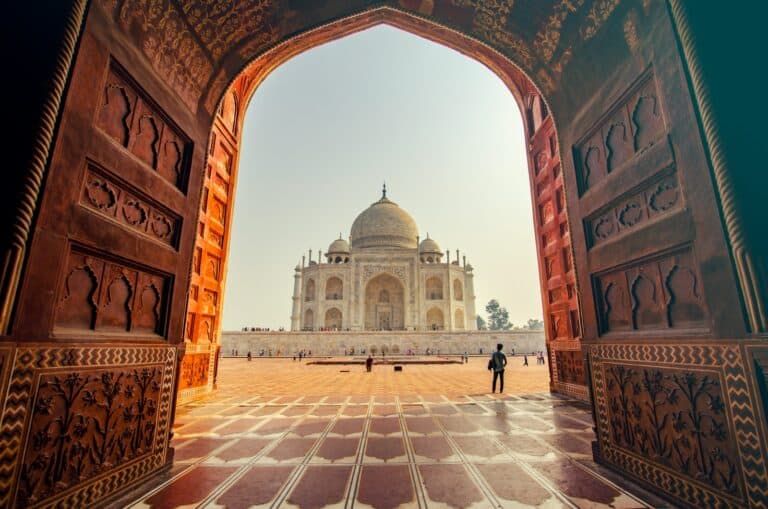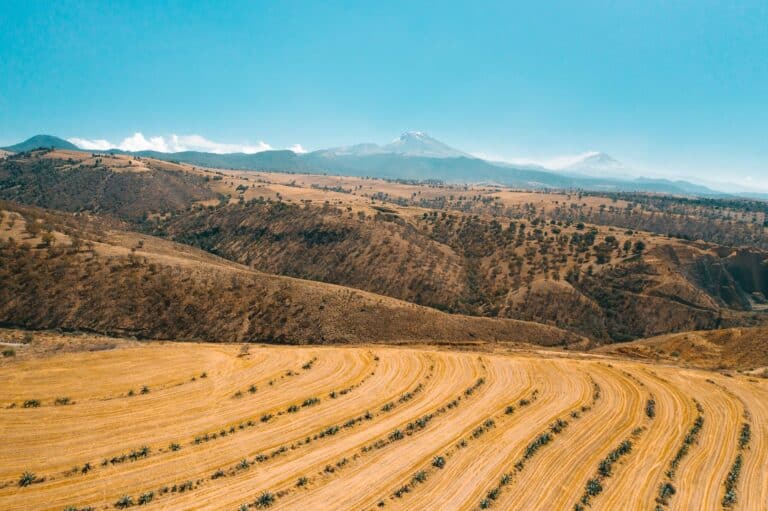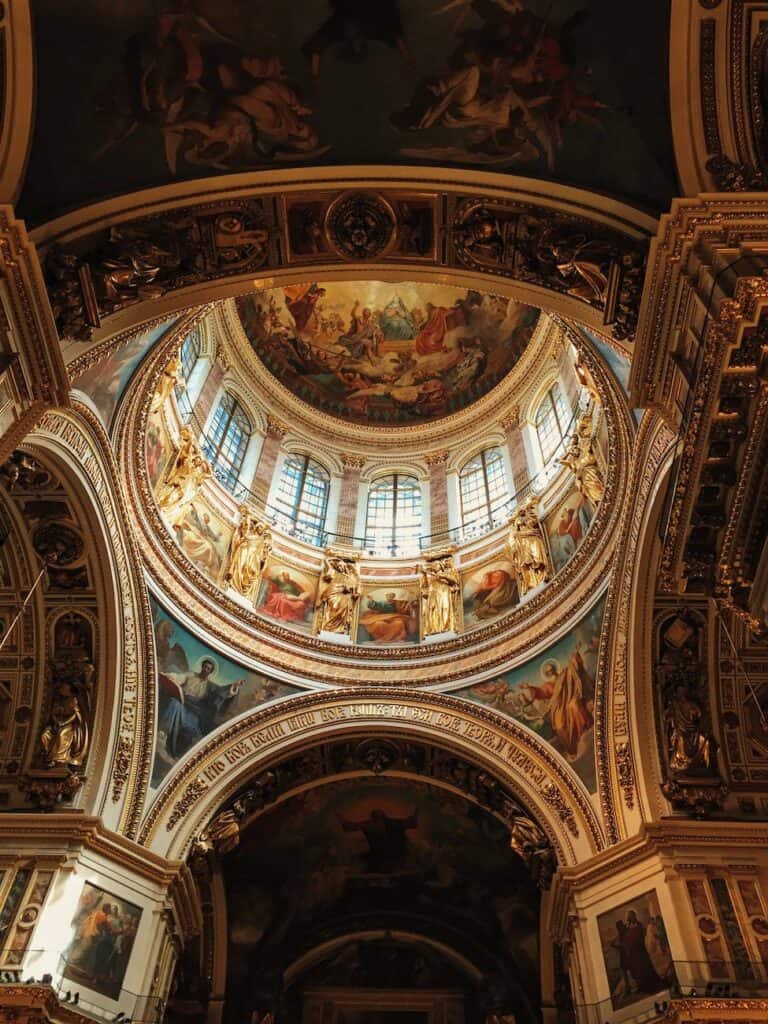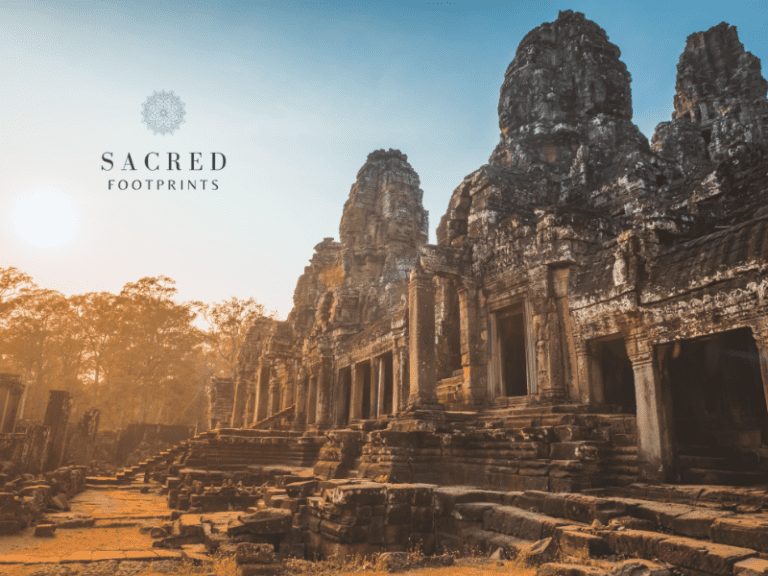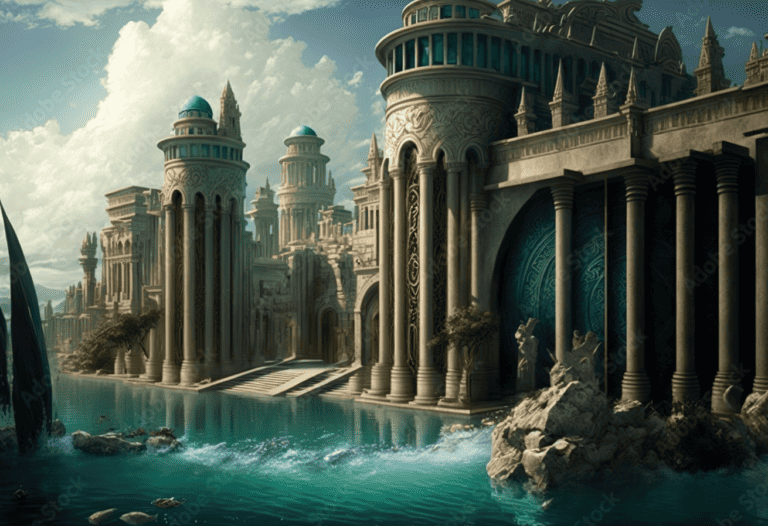The Gunung Padang Megalithic Site: Uncovering New Depths of History
The fascinating UNESCO World Heritage Gunung Padang Megalithic Site stands as an enigmatic relic of a bygone era, shrouded in mystery and controversy.
Nestled amidst the lush Indonesian landscape, this archaeological marvel, believed to predate recorded human history, has captured the imaginations of scientists, historians, and explorers alike, offering tantalizing hints of an ancient civilization that may have thrived long before our textbooks suggest.
In this blog, we embark on a journey to uncover the secrets of Gunung Padang, exploring its origins, the myths and legends that surround it, and the fervent debates regarding its age.
As we delve into the depths of this site, we’ll unveil the groundbreaking theories that challenge our understanding of human evolution and hint at the existence of advanced civilizations in the distant past.
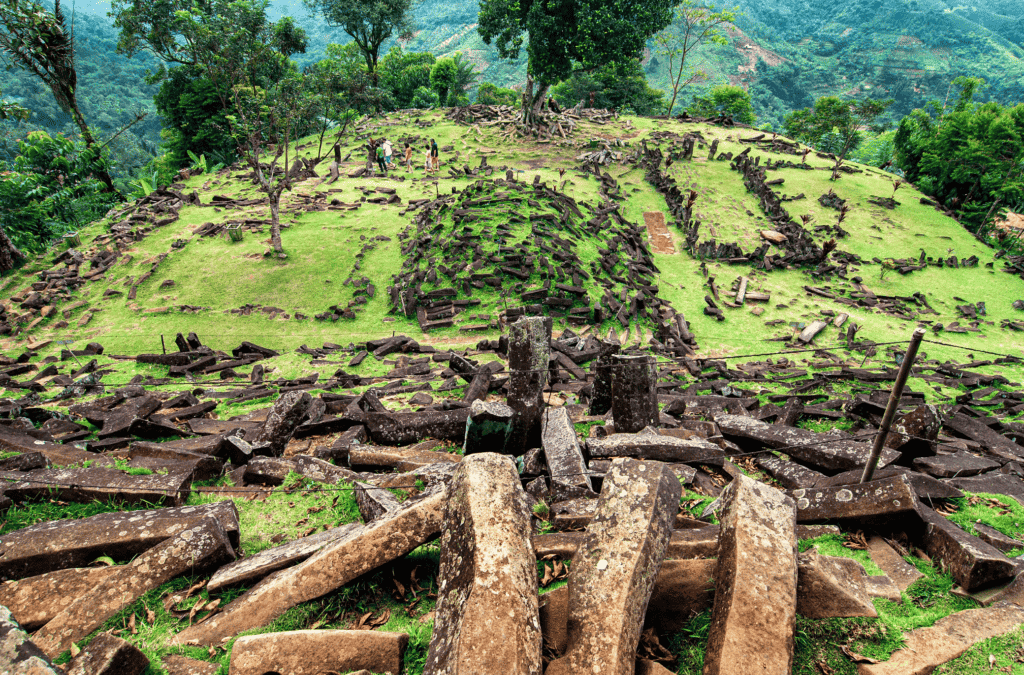
Table of Contents
Where is The Gunung Padang Megalithic Site?
The Gunung Padang Megalithic Site is located in West Java, Indonesia, in the scenic Cianjur Regency. The area is steeped in Sundanese culture, where traditions, music, dance, and spirituality play a vital role. The Sundanese people, the predominant ethnic group, have a rich history dating back centuries.
Local culture is celebrated through vibrant art forms like the angklung, a bamboo musical instrument, and the dynamic Jaipongan dance. Spirituality is deeply ingrained, with a blend of animistic beliefs, Hindu-Buddhist traditions, and Islam.
The Gunung Padang Site holds special spiritual significance. It is believed to be a sacred place bridging the earthly and spiritual realms. Legends tell of an ancient advanced society that once thrived here.
It’s a UNESCO World Heritage candidate, symbolizing the enduring legacy of the Sundanese culture and its deep connection to the land. The site attracts visitors and researchers worldwide, eager to uncover its ancient mysteries and appreciate the cultural richness it represents.

How Old is the Gunung Pandang Megalithic Site?
The age of the Gunung Padang Megalithic Site has been a subject of intense debate among historians and archaeologists. Initially, it was considered 2,500 to 3,000 years old, placing it within the Bronze Age.
However, recent research and advanced dating techniques have challenged these initial estimates. Some studies suggest that the site’s origins reach back much further, potentially to an astonishing 20,000 to 22,000 years ago. This controversial claim has sparked fervent discussions within the archaeological community.
On the hit Netflix show Ancient Apocolypse, Graham Hancock, the British author, journalist, and researcher, has taken a keen interest in the Gunung Padang Megalithic Site.
Graham Handcock is known for his work on unconventional theories about ancient civilizations, prehistory, and human history. He has written several bestselling books, including “Fingerprints of the Gods” and “Magicians of the Gods,” in which he explores alternative perspectives on the origins of human civilization and the possibility of advanced ancient cultures.
Hancock proposed the controversial idea that the site may be much older than traditionally believed, potentially dating back tens of thousands of years. Hancock’s theories have sparked lively debates among historians, archaeologists, and scholars regarding the age and significance of the Gunung Padang Site.
Critics argue that the advanced age proposed for the site challenges established timelines of human history and the development of complex societies. They call for further research and scrutiny to validate these groundbreaking claims.
Despite these controversies, the Gunung Padang Megalithic Site continues to be a focal point for archaeological investigations, with researchers working tirelessly to unlock the secrets concealed within its ancient stones.
The ongoing quest to determine its true age promises to reshape our understanding of human civilization and the potential for advanced cultures in the distant past.

Travelling around Indonesia? Check out my Ultimate Bali Guides: 5-Days in Bali & 3 Weeks in Bali Guide!
Spiritual and Cultural Significance:
The Gunung Padang Megalithic Site in West Java, Indonesia, holds profound spiritual and cultural importance. It is believed to have been a sacred ceremonial site for ancient inhabitants.
The layered terraces and massive megalithic stones witness ceremonies, rituals, and gatherings that connect people to the spiritual realm.
Purpose and Construction:
While the exact purpose of Gunung Padang remains a subject of debate, many theories suggest it was a place of worship, meditation, or even a centre for astronomical observations.
The intricate construction, utilizing columnar basalt stones and precise alignments, showcases architectural mastery that hints at a sophisticated society.
Links to Other Sites Worldwide:
The Gunung Padang Site shares intriguing parallels with other ancient sites worldwide. Its tiered construction and megalithic stones resonate with structures like the famous pyramids of Egypt and the lesser-known ziggurats of Mesopotamia. This suggests a potential global network of shared architectural knowledge or a universal understanding of sacred geometry.
Sacred Geometry and Architecture:
At the heart of Gunung Padang lies the concept of sacred geometry. The precise arrangement of stones and the careful consideration of proportions reflect an ancient understanding of cosmic harmonies and the interconnectedness of all things.
Sacred architecture and geometry are profound concepts that explore the interplay between the physical world and the spiritual or metaphysical realms.
Sacred Architecture:
Sacred Architecture involves the intentional design and construction of spaces, buildings, or structures imbued with symbolic, religious, or spiritual meaning. It goes beyond mere functionality to create environments that provoke a sense of transcendence and connection to the divine.
Sacred Geometry:
Sacred Geometry on the other hand, is a mathematical and geometric language used to create these spiritually significant spaces. It involves the precise use of geometric shapes, ratios, and proportions that are believed to hold inherent cosmic and metaphysical significance. This ancient practice suggests that certain geometric forms resonate with universal energies, aligning the physical world with higher states of consciousness.
Together, sacred architecture and geometry represent a powerful fusion of art, science, and spirituality, aiming to create spaces that inspire awe, contemplation, and a deep sense of the sacred.
Unique to Java or a Global Phenomenon:
While Gunung Padang stands as a unique testament to the cultural and spiritual practices of ancient Java, its architectural elements and potential symbolic significance echo in structures worldwide.
This suggests a shared human understanding of the profound relationship between architecture, spirituality, and the cosmos.
There are other famous and significant sites in Java, such as Borobudur. Borobodur is a 9th-century Buddhist temple complex that showcases Mahayana Buddhist artistry and philosophy through its nine-tiered structure adorned with intricate carvings and Buddha statues.
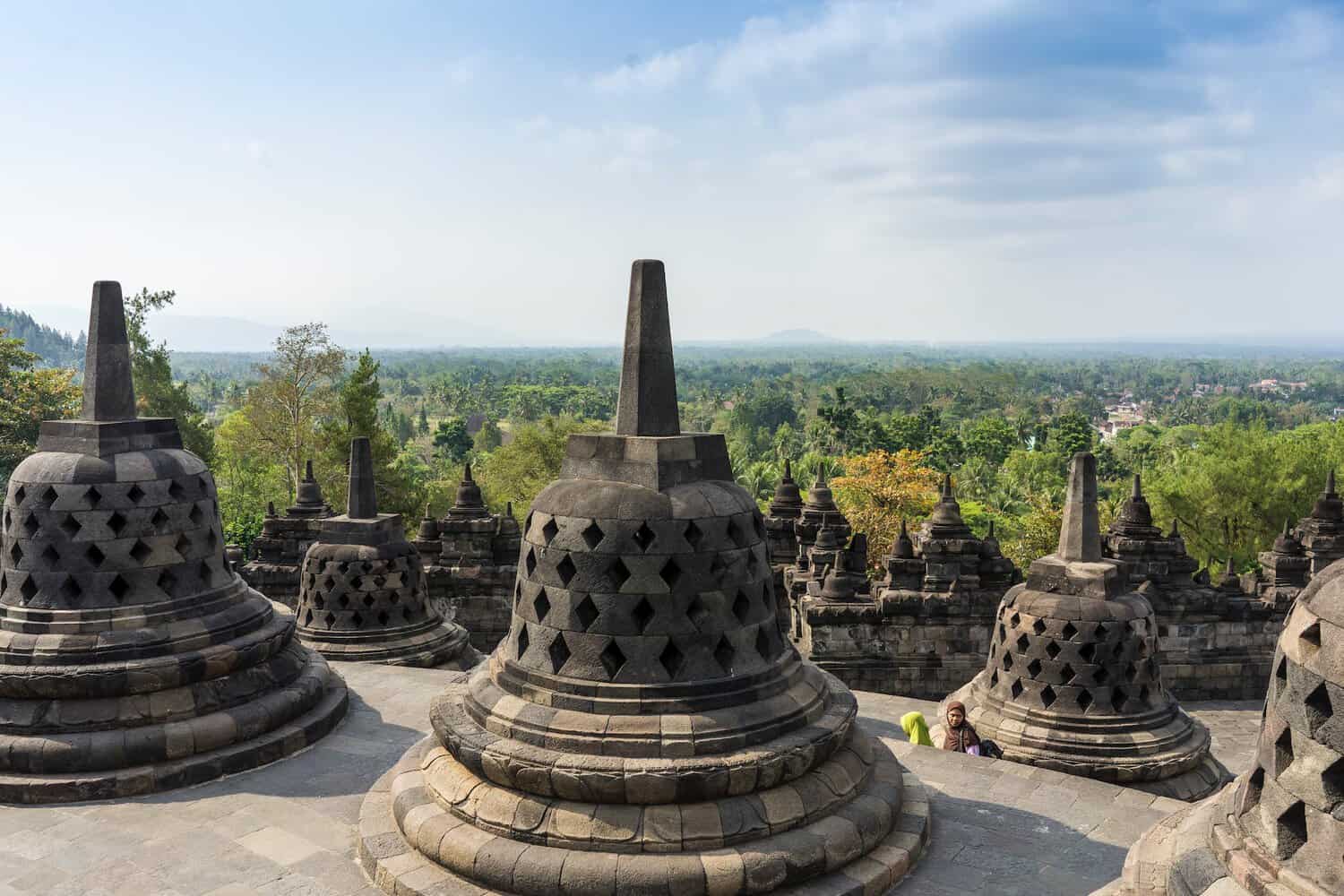
While Borobudur represents the cosmic journey towards enlightenment, Gunung Padang’s enigmatic age reevaluates ancient civilizations’ sophistication.
Furthermore, Prambanan, a 9th-century Hindu temple complex, pays homage to the Trimurti and is a testament to ancient Javanese Hindu devotion. Its towering structures and detailed stone carvings exemplify the grandeur of Javanese Hindu art and culture.
These distinct sites, each with its own purpose, design, and cultural context, collectively narrate the diverse spiritual and artistic heritage of ancient Java, challenging and enriching our understanding of the island’s ancient civilizations.
In essence, the Gunung Padang Megalithic Site is a testament to the enduring legacy of Java’s ancient cultures and their quest for connection to the spiritual realm. Its unique construction, combined with its potential global resonance, invites us to contemplate the shared wisdom of our ancestors and the timeless significance of sacred spaces.
Why is Gunung Padang so Unique in its Architecture?
The Gunung Padang Megalithic Site stands out for several unique features in its structure, construction, and materials:
Layered Construction:
One of the most distinctive aspects of Gunung Padang is its layered structure. It consists of several tiers or terraces, each built on top of the previous one. This architectural design is unusual for megalithic sites and has led to speculation about its purpose and age.
Megalithic Stones:
The site uses massive stone blocks, some weighing several tons. These megalithic stones are arranged in a way that suggests careful planning and engineering. The precision in the placement of these stones has intrigued researchers, as it indicates a high level of architectural sophistication.
Columnar Basalt:
Many of the stones used in the construction of Gunung Padang are made of columnar basalt. This type of rock is known for its natural hexagonal columnar structure, which occurs when lava cools and contracts. The use of columnar basalt at Gunung Padang is significant, as it is a challenging material to work with due to its hardness.
Subsurface Structures:
Beneath the surface layers of Gunung Padang, there are indications of even older structures. These subterranean layers have been a subject of great interest and have fueled speculation about the site’s age.
Alignment with Natural Features:
Some researchers have noted alignments between the megalithic structures at Gunung Padang and certain natural features, such as nearby mountains. This has led to speculation about potential astronomical or geomantic significance.
Potential for Water Management:
Some experts have suggested that Gunung Padang may have had functions related to water management, as there are channels and water-related features on the site.
These unique characteristics have contributed to the intrigue surrounding Gunung Padang. Researchers are continually working to unravel the purpose and age of this enigmatic megalithic site, and the distinctiveness of its construction and materials plays a central role in this ongoing exploration.

How to Get to the Gunung Padang Megalithic Site:
To get to the Gunung Padang Megalithic Site in West Java, you can start from significant entry points in Java, such as Jakarta, Bandung, or Yogyakarta.
Travel Tip: I love using Rome2Rio to plan my travels in new countries. It helps you see what transport options are available to get you from A to B.
But briefly, here’s how to reach the Gunung Padang Megalithic Site from these cities:
From Jakarta:
- By Air: Jakarta’s Soekarno-Hatta International Airport (CGK) is the leading international gateway. From there, you can fly to Husein Sastranegara International Airport in Bandung.
- By Land: From Jakarta, you can also take a train or bus to Bandung. The train journey offers scenic views and takes about 3-4 hours. Buses are also available and take approximately 3-4 hours.
From Bandung:
- By Land: From Bandung, you can hire a car or taxi to Gunung Padang. The journey by car takes about 2-3 hours, depending on traffic and road conditions.
From Yogyakarta:
- By Air: Adisucipto International Airport (JOG) is the main airport in Yogyakarta. From there, you can fly to Bandung or Jakarta before proceeding to Gunung Padang.
- By Land: Yogyakarta is well-connected by train and bus services. You can take a train to Bandung or Jakarta and then continue by land to Gunung Padang.
Best Transport Options:
- Air Travel: Flying into Jakarta or Bandung is the fastest way to reach Java. Jakarta’s Soekarno-Hatta International Airport and Bandung’s Husein Sastranegara International Airport are well-connected to major international and domestic destinations.
- Train Travel: Indonesia has an extensive train network, and travelling by train can be a comfortable and scenic option. Trains operate between major cities in Java, including Jakarta, Bandung, and Yogyakarta.
- Bus/Minivan: For a more budget-friendly option, you can take a long-distance bus or minivan. These are widely available and connect major cities in Java.
- Car Rental: Renting a car with a driver is a convenient travel method, especially if you prefer flexibility and comfort. It’s advisable to hire a local driver who is familiar with the roads and traffic conditions.
- Taxi/Local Transport: In cities like Jakarta and Bandung, you can use ride-hailing services or traditional taxis to get around. Local transport options like angkot (minivans) or ojek (motorcycle taxis) are also available.
Remember to check local transportation options and schedules and plan your journey accordingly. Additionally, consider traffic conditions, especially during peak travel times.
Best Places to Stay to Visit the Gunung Padang Megalithic Site:
If you plan to visit the Gunung Padang Megalithic Site, the town of Cianjur in West Java, Indonesia, is the most convenient place to stay. Cianjur offers a range of accommodation options to suit different budgets and preferences. Here are some recommended options:
- Hotel Augusta Cianjur: This is a popular choice among visitors. It offers comfortable rooms and good amenities and is located conveniently for exploring Gunung Padang.
- Aston Bogor Hotel and Resort: While far from Gunung Padang, this resort offers a serene setting with lush gardens and modern amenities.
- Le Eminence Hotel: This hotel is situated on a hill, providing beautiful views of the surrounding area. It’s a bit further from Gunung Padang but offers a peaceful atmosphere.
- Hotel Royal: Located in Cianjur town, Hotel Royal provides comfortable and affordable accommodation options, making it a convenient base for exploring the area.
- Airbnb: There are also various Airbnb options available in Cianjur and the surrounding areas, providing a chance to stay in local homes or guesthouses.
When planning your visit, be sure to check the availability and book in advance, especially during peak travel seasons. Additionally, consider factors like proximity to Gunung Padang, transportation options, and any specific amenities or services you may require during your stay.
Conclusion on the Gunung Padang Megalithic Site
In conclusion, the Gunung Padang Megalithic Site stands as a testament to the profound mysteries that lie beneath the surface of our understanding of ancient civilizations.
Its layered terraces and colossal megalithic stones challenge established timelines, suggesting a history that predates recorded human records.
The potential alignments with natural features and the precision of its construction hint at a sophisticated understanding of sacred geometry and cosmic symbolism.
As we contemplate the significance of Gunung Padang, we are reminded of the boundless depths of human ingenuity and the ceaseless quest to uncover our ancient roots.
This enigmatic site sparks curiosity, inviting researchers and explorers to delve deeper into its secrets. It serves as a potent reminder that there is still much to learn about the intricate tapestry of human history, and Gunung Padang is a key thread in that larger narrative.
In its silent stones and ancient whispers, we glimpse a tantalizing glimpse of a civilization that existed on the cusp of time, urging us to continue our quest and thirst for knowledge and understanding.
Suppose you are planning a visit to this fascinating site. In that case, you will be sure to leave captivated and longing to understand the site’s mysteries and human history, like everyone before you.
RECENT POSTS on Sacred Footprints
- Which Countries Best Represent Our 5 Senses? – Beautiful, & Sensual Destinations
 Have you ever wondered which countries best represent our 5 senses? Our entire human experience is held in our sensory experience, and travel evokes a…
Have you ever wondered which countries best represent our 5 senses? Our entire human experience is held in our sensory experience, and travel evokes a… - The Best Sustainable Eco-Tourism Places to Stay in Mexico 2024 – Beautiful & Unique Stays
 Looking for the Best Eco-Tourism Places to Stay in Mexico? Well, we have got you covered. After all, we are in 2024, and with the…
Looking for the Best Eco-Tourism Places to Stay in Mexico? Well, we have got you covered. After all, we are in 2024, and with the… - Can Solo Travellers Safely Explore India? An Ultimate Guide!
 So, can solo travellers safely explore India? We are here to help you answer that question. India is definitely a mixed bag! My six-week journey…
So, can solo travellers safely explore India? We are here to help you answer that question. India is definitely a mixed bag! My six-week journey… - How To Plan an Epic Budget-Friendly Trip to Southeast Asia
 Are you looking for tips on how to plan a budget-friendly trip to Southeast Asia? We’ve got you covered. Budget travel is all about balance….
Are you looking for tips on how to plan a budget-friendly trip to Southeast Asia? We’ve got you covered. Budget travel is all about balance…. - Sustainable Tourism Options in Mexico – An Implementation of Hope
 Are you wondering if there are sustainable tourism options in Mexico? Well, the answer is yes, absolutely! Mexico is forthcoming in sustainable and eco-tourism, with…
Are you wondering if there are sustainable tourism options in Mexico? Well, the answer is yes, absolutely! Mexico is forthcoming in sustainable and eco-tourism, with… - Exploring the Impact of Tourism on Culture: A Global Perspective
 What is the true impact of tourism on culture? As travellers, we are often enchanted by the allure of exploring new cultures and experiencing the…
What is the true impact of tourism on culture? As travellers, we are often enchanted by the allure of exploring new cultures and experiencing the…








